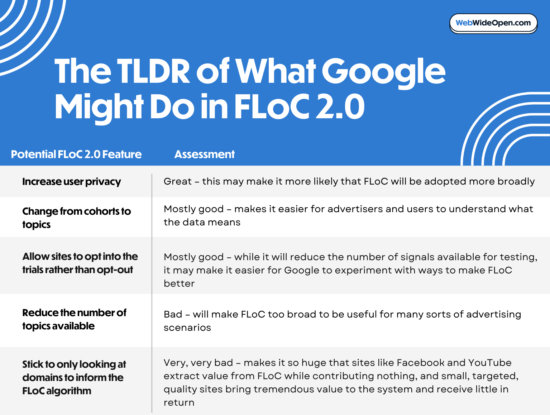
What Google Might Do with FLoC 2.0
Paul Bannister, CafeMedia's Chief Strategy Officer, examines what went right — and wrong — during the first FLoC trial as well as what direction Google may go with the next version of this new technology. He analyzes how Google's choices will affect the digital ads ecosystem.
Earlier this year, Google made two major announcements that will potentially shape the direction of digital advertising.
I‘m betting you missed the more important one.
The first announcement made headlines — cookies got a stay of execution until 2023!
Announcement number two was hardly noticed yet could have just as big of an impact on our business — Federated Learning of Cohorts, which I‘ll call FLoC 1.0, was over.
At some point in the near future, FLoC 2.0 is coming. How it shakes out could determine how digital ad targeting will work for much of the open web. It may also impact regulators‘ stance on whether the industry is on a path toward respecting consumer privacy.
Regardless of timing, cookies were always set to disappear. What replaces them may dictate the future economics of digital publishing. That‘s how influential Google is, and that‘s how consequential FLoC may prove to be.
Therefore, we believe it‘s imperative to examine what Google got right — and wrong — during the first FLoC trial and to advocate for improvements that will benefit the entire ad ecosystem.

The Story to Date
Google‘s Federated Learning of Cohorts proposal was meant to support interest-based advertising in the future. While there was plenty of angst that Google was once again assuming a unilateral role in this proposed initiative, there were some early signs that FLoC could actually work quite well.
Of course, there were other signals that it wasn‘t going to work in its current iteration. But it was certainly clear that more time was necessary to really test this new system out, a fact that Google seems to understand, as evidenced by the much longer time frames they are presenting now on their Privacy Sandbox site.
Privacy advocates have different issues with the initial version of FLoC (which was identified as Chrome.2.1 in the first origin trial) — many related to the simple fact that for something billed as pro privacy, FLoC 1.0 allowed browsers to collect too much personal information on web users. FLoC 1.0 actually allows browsers to collect more data than before, putting the Chromes of the world in position to create fingerprints of users and making it easier for people to be tracked.
Additional concerns are that FLoC 1.0:
- Could violate “longitudinal privacy” — allowing trackers to collect different data about users over time.
- Might create cohorts that could discriminate against different protected classes.
- Forced sites to opt out if they didn‘t want to be a part of the algorithm.
These issues and more are best documented in a blog post and a research paper from Mozilla.
To its credit, Google has taken these privacy criticisms to heart. While it‘s unclear what path they will pursue, it‘s almost definite that FLoC 2.0 will have fewer privacy problems — which is a good thing. What‘s less clear is how the next iteration of their proposal might work for advertising, which is obviously the other key requirement.
What Comes Next
The main place to gather clues about the next version of FLoC is from a presentation given by Josh Karlin at an IETF (Internet Engineering Task Force) event in July. The IETF is a standards organization that makes decisions around the infrastructure of the internet — network routers, data protocols and other behind-the-scenes technology that keeps the internet functioning. Josh is a tech lead manager on the Privacy Sandbox team at Chrome and one of the main voices in W3C discussions on FLoC.
Josh reveals some key changes that will likely affect the way advertisers will be able to use FLoC 2.0.
Josh talks about moving away from “cohorts” to “topics.” In some ways, this is semantics — both are just segments of users. But the key nuance here is that cohorts were defined only by how the first FLoC algorithm “bucketed” a given user. Cohorts were just numbers, with no direct tie to what they actually meant.
On the other hand, topics are defined in advance and are human-readable. For users, that‘s a benefit, as they can easily understand what they are being assigned to and control that more easily. From an advertising perspective, I think topics are far worse on a number of levels.
Say Goodbye to Precision
Numerical cohorts, while more complex to understand, allow for more flexibility in targeting. Different companies can find different correlations that would allow them to build better segments. They can be combined with other data points (like context, region, etc.) to build more sophisticated models. A topic-driven model will likely be a loss for targeting.
The next potential change is a real killer for advertising — changing the number of topics/segments from 16 bits of data to 8 bits. Said in regular numbers, this is going from around 32,000 different segment possibilities to 256 — an enormous loss of targeting information.
Put in layman‘s terms, if you are already despondent over the inevitable decline in retargeting and you‘re worried that digital advertising is about to go from precise one-to-one-targeting to spitting in the wind, this will not make you feel better.
For a point of comparison, the IAB Audience Taxonomy has just shy of 1,700 segments. That taxonomy is a pretty solid framework, but you can easily spot holes. In the “Purchase Intent -> Consumer Packaged Goods -> Non-edible -> Household Appliances” part of the taxonomy are 27 subcategories like Food Processors, Breadmakers and Freezers. Missing are Air Fryers, Pasta Makers, Electric Grills and many other subcategories of intent that could be useful for a marketer. However, the IAB Taxonomy is designed to be updated and has space to add many more.
A FLoC 2.0 with only 256 topics would be forced to roll up those 27 subcategories into just “Household Appliances.” A consumer looking to buy a refrigerator is vastly different from one looking to buy a breadmaker, and a marketer looking to spend their advertising dollars effectively would likely ignore that segment altogether (and spend that money in a walled garden). Maybe a happy medium can be found here (12 bits, with a commitment to update the segment list at least quarterly?), but 8 bits alone would be a big hit to FLoC.
Bigger Is Not Always Better
When Josh is talking about the idea of converting from cohorts to topics, the slide mentions a minute detail that he doesn‘t bring up: “Consider providing topics based on domains instead of cohorts.” The key word in that statement is “domains.” The first FLoC origin trial only looked at domains to calculate the cohort, but there has been much discussion in W3C groups around drilling down further to URLs or metadata or the actual context of the page. Josh‘s statement seems to imply that FLoC 2.0 could continue using domains.
For marketers and quality publishers, this is very bad. In a world where domain is the key driver of the user segment, enormous websites contribute very little (the fact that a user visits YouTube or Facebook is nearly meaningless — basically everyone goes to those sites), and small websites that have very targeted content add tremendous value to the system. Large companies are also likely to have third-party sign-in scripts that can collect FLoC data on their users even if the company‘s domain is opted out.
So to go back to our Household Appliances example, a user who visits a site called “appliancereviews.com” (not a real site) and views five pages would likely be classified by FLoC 2.0 into a “Household Appliance Intender” segment. But a user who watched five appliance review videos on YouTube would NOT be classified this way, as the domain for each of those video views is youtube.com. (This is an oversimplified example for illustrative purposes.)
This allows extremely large websites to gain tremendous value from a system where almost all of the value is created by small sites. And the small sites get no benefit from the presence of the large sites within the ecosystem. If this is, in fact, the case, I would consider advising all small sites to turn off FLoC 2.0.
Who‘s Part of the FLoC?
In fact, site opt-in is another significant change planned for future origin trials. Google received a lot of negative PR around sites and organizations opting out, and it‘s possible that making “site opt-in” a permanent requirement might be a part of the final version of FLoC. It would certainly lower the pressure on Google, which is one thing they are absolutely trying to do.
From an advertising perspective, there are pros and cons of this choice. Automatic opt-in to FLoC (among sites that have adtech code running) increases the number of sites participating, which means more signals for FLoC to consume — and better advertiser outcomes.
On the flip side, enabling sites to opt in to FLoC might give Google more wiggle room on the privacy side. If only sites that want to participate are joining, those sites (broadly) may make more responsible decisions about the types of data they would share about their users. This could give Google some justification for FLoC to release a bit more data about users — which would be good for advertisers.
The Silver Lining, or Not
So FLoC 2.0 appears to be heading toward a pretty major revamp compared to FLoC 1.0. It‘ll be interesting to see how far Google goes with some of the changes, as some have the potential to make things better, but others have the potential to render FLoC mostly unusable for advertising purposes or for any publisher benefit. Currently, the next origin trial is slated for Q1 of 2022, so we‘ll learn a lot more about the direction of FLoC closer to that time.


